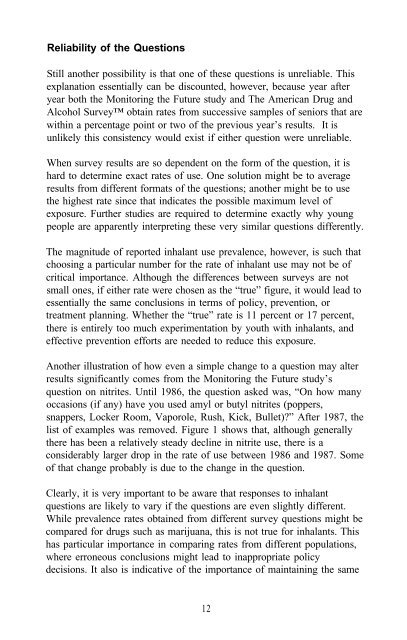Epidemiology of Inhalant Abuse - Archives - National Institute on ...
Epidemiology of Inhalant Abuse - Archives - National Institute on ...
Epidemiology of Inhalant Abuse - Archives - National Institute on ...
Create successful ePaper yourself
Turn your PDF publications into a flip-book with our unique Google optimized e-Paper software.
Reliability <str<strong>on</strong>g>of</str<strong>on</strong>g> the Questi<strong>on</strong>s<br />
Still another possibility is that <strong>on</strong>e <str<strong>on</strong>g>of</str<strong>on</strong>g> these questi<strong>on</strong>s is unreliable. This<br />
explanati<strong>on</strong> essentially can be discounted, however, because year after<br />
year both the M<strong>on</strong>itoring the Future study and The American Drug and<br />
Alcohol Survey obtain rates from successive samples <str<strong>on</strong>g>of</str<strong>on</strong>g> seniors that are<br />
within a percentage point or two <str<strong>on</strong>g>of</str<strong>on</strong>g> the previous year’s results. It is<br />
unlikely this c<strong>on</strong>sistency would exist if either questi<strong>on</strong> were unreliable.<br />
When survey results are so dependent <strong>on</strong> the form <str<strong>on</strong>g>of</str<strong>on</strong>g> the questi<strong>on</strong>, it is<br />
hard to determine exact rates <str<strong>on</strong>g>of</str<strong>on</strong>g> use. One soluti<strong>on</strong> might be to average<br />
results from different formats <str<strong>on</strong>g>of</str<strong>on</strong>g> the questi<strong>on</strong>s; another might be to use<br />
the highest rate since that indicates the possible maximum level <str<strong>on</strong>g>of</str<strong>on</strong>g><br />
exposure. Further studies are required to determine exactly why young<br />
people are apparently interpreting these very similar questi<strong>on</strong>s differently.<br />
The magnitude <str<strong>on</strong>g>of</str<strong>on</strong>g> reported inhalant use prevalence, however, is such that<br />
choosing a particular number for the rate <str<strong>on</strong>g>of</str<strong>on</strong>g> inhalant use may not be <str<strong>on</strong>g>of</str<strong>on</strong>g><br />
critical importance. Although the differences between surveys are not<br />
small <strong>on</strong>es, if either rate were chosen as the “true” figure, it would lead to<br />
essentially the same c<strong>on</strong>clusi<strong>on</strong>s in terms <str<strong>on</strong>g>of</str<strong>on</strong>g> policy, preventi<strong>on</strong>, or<br />
treatment planning. Whether the “true” rate is 11 percent or 17 percent,<br />
there is entirely too much experimentati<strong>on</strong> by youth with inhalants, and<br />
effective preventi<strong>on</strong> efforts are needed to reduce this exposure.<br />
Another illustrati<strong>on</strong> <str<strong>on</strong>g>of</str<strong>on</strong>g> how even a simple change to a questi<strong>on</strong> may alter<br />
results significantly comes from the M<strong>on</strong>itoring the Future study’s<br />
questi<strong>on</strong> <strong>on</strong> nitrites. Until 1986, the questi<strong>on</strong> asked was, “On how many<br />
occasi<strong>on</strong>s (if any) have you used amyl or butyl nitrites (poppers,<br />
snappers, Locker Room, Vaporole, Rush, Kick, Bullet)?” After 1987, the<br />
list <str<strong>on</strong>g>of</str<strong>on</strong>g> examples was removed. Figure 1 shows that, although generally<br />
there has been a relatively steady decline in nitrite use, there is a<br />
c<strong>on</strong>siderably larger drop in the rate <str<strong>on</strong>g>of</str<strong>on</strong>g> use between 1986 and 1987. Some<br />
<str<strong>on</strong>g>of</str<strong>on</strong>g> that change probably is due to the change in the questi<strong>on</strong>.<br />
Clearly, it is very important to be aware that resp<strong>on</strong>ses to inhalant<br />
questi<strong>on</strong>s are likely to vary if the questi<strong>on</strong>s are even slightly different.<br />
While prevalence rates obtained from different survey questi<strong>on</strong>s might be<br />
compared for drugs such as marijuana, this is not true for inhalants. This<br />
has particular importance in comparing rates from different populati<strong>on</strong>s,<br />
where err<strong>on</strong>eous c<strong>on</strong>clusi<strong>on</strong>s might lead to inappropriate policy<br />
decisi<strong>on</strong>s. It also is indicative <str<strong>on</strong>g>of</str<strong>on</strong>g> the importance <str<strong>on</strong>g>of</str<strong>on</strong>g> maintaining the same<br />
12
















